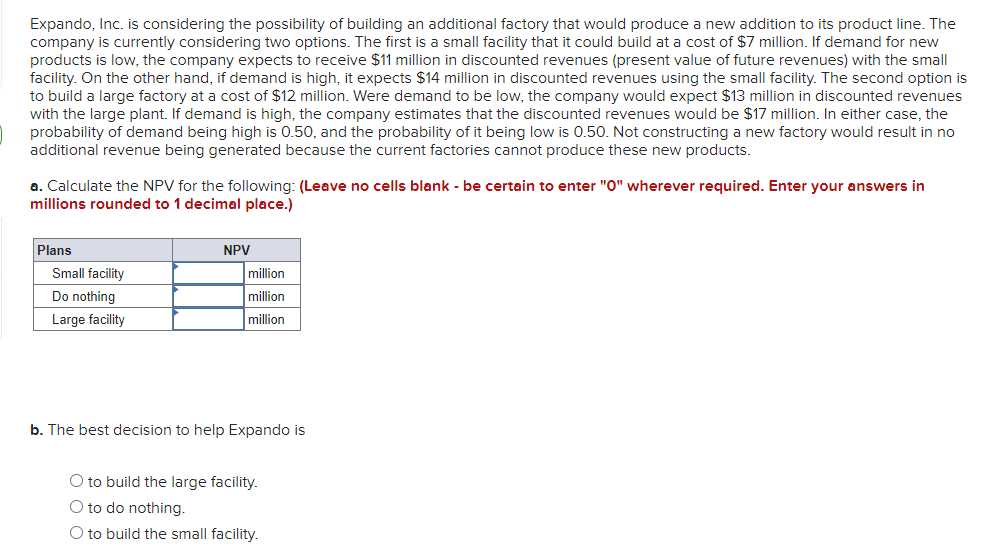Expando, Inc. is considering the possibility of building an additional factory that would produce a new addition to its product line. The company is currently considering two options. The first is a small facility that it could build at a cost of $7 million. If demand for new products is low, the company expects to receive $11 million in discounted revenues (present value of future revenues) with the small facility. On the other hand, if demand is high, it expects $14 million in discounted revenues using the small facility. The second option i to build a large factory at a cost of $12 million. Were demand to be low, the company would expect $13 million in discounted revenues with the large plant. If demand is high, the company estimates that the discounted revenues would be $17 million. In either case, the probability of demand being high is 0.50, and the probability of it being low is 0.50. Not constructing a new factory would result in no additional revenue being generated because the current factories cannot produce these new products. a. Calculate the NPV for the following: (Leave no cells blank - be certain to enter "O" wherever required. Enter your answers in millions rounded to 1 decimal place.) Plans NPV Small facility million Do nothing million Large facility million b. The best decision to help Expando is to build the large facility. O to do nothing.
Expando, Inc. is considering the possibility of building an additional factory that would produce a new addition to its product line. The company is currently considering two options. The first is a small facility that it could build at a cost of $7 million. If demand for new products is low, the company expects to receive $11 million in discounted revenues (present value of future revenues) with the small facility. On the other hand, if demand is high, it expects $14 million in discounted revenues using the small facility. The second option i to build a large factory at a cost of $12 million. Were demand to be low, the company would expect $13 million in discounted revenues with the large plant. If demand is high, the company estimates that the discounted revenues would be $17 million. In either case, the probability of demand being high is 0.50, and the probability of it being low is 0.50. Not constructing a new factory would result in no additional revenue being generated because the current factories cannot produce these new products. a. Calculate the NPV for the following: (Leave no cells blank - be certain to enter "O" wherever required. Enter your answers in millions rounded to 1 decimal place.) Plans NPV Small facility million Do nothing million Large facility million b. The best decision to help Expando is to build the large facility. O to do nothing.
Essentials of Business Analytics (MindTap Course List)
2nd Edition
ISBN:9781305627734
Author:Jeffrey D. Camm, James J. Cochran, Michael J. Fry, Jeffrey W. Ohlmann, David R. Anderson
Publisher:Jeffrey D. Camm, James J. Cochran, Michael J. Fry, Jeffrey W. Ohlmann, David R. Anderson
Chapter15: Decision Analysis
Section: Chapter Questions
Problem 10P: Hemmingway, Inc. is considering a $5 million research and development (R&D) project. Profit...
Related questions
Question
100%

Transcribed Image Text:Expando, Inc. is considering the possibility of building an additional factory that would produce a new addition to its product line. The
company is currently considering two options. The first is a small facility that it could build at a cost of $7 million. If demand for new
products is low, the company expects to receive $11 million in discounted revenues (present value of future revenues) with the small
facility. On the other hand, if demand is high, it expects $14 million in discounted revenues using the small facility. The second option is
to build a large factory at a cost of $12 million. Were demand to be low, the company would expect $13 million in discounted revenues
with the large plant. If demand is high, the company estimates that the discounted revenues would be $17 million. In either case, the
probability of demand being high is 0.50, and the probability of it being low is 0.50. Not constructing a new factory would result in no
additional revenue being generated because the current factories cannot produce these new products.
a. Calculate the NPV for the following: (Leave no cells blank - be certain to enter "O" wherever required. Enter your answers in
millions rounded to 1 decimal place.)
Plans
NPV
Small facility
million
Do nothing
million
Large facility
million
b. The best decision to help Expando is
O to build the large facility.
O to do nothing.
O to build the small facility.
Expert Solution
This question has been solved!
Explore an expertly crafted, step-by-step solution for a thorough understanding of key concepts.
This is a popular solution!
Trending now
This is a popular solution!
Step by step
Solved in 2 steps with 1 images

Knowledge Booster
Learn more about
Need a deep-dive on the concept behind this application? Look no further. Learn more about this topic, accounting and related others by exploring similar questions and additional content below.Recommended textbooks for you

Essentials of Business Analytics (MindTap Course …
Statistics
ISBN:
9781305627734
Author:
Jeffrey D. Camm, James J. Cochran, Michael J. Fry, Jeffrey W. Ohlmann, David R. Anderson
Publisher:
Cengage Learning

EBK CONTEMPORARY FINANCIAL MANAGEMENT
Finance
ISBN:
9781337514835
Author:
MOYER
Publisher:
CENGAGE LEARNING - CONSIGNMENT


Essentials of Business Analytics (MindTap Course …
Statistics
ISBN:
9781305627734
Author:
Jeffrey D. Camm, James J. Cochran, Michael J. Fry, Jeffrey W. Ohlmann, David R. Anderson
Publisher:
Cengage Learning

EBK CONTEMPORARY FINANCIAL MANAGEMENT
Finance
ISBN:
9781337514835
Author:
MOYER
Publisher:
CENGAGE LEARNING - CONSIGNMENT



Intermediate Financial Management (MindTap Course…
Finance
ISBN:
9781337395083
Author:
Eugene F. Brigham, Phillip R. Daves
Publisher:
Cengage Learning

Financial And Managerial Accounting
Accounting
ISBN:
9781337902663
Author:
WARREN, Carl S.
Publisher:
Cengage Learning,